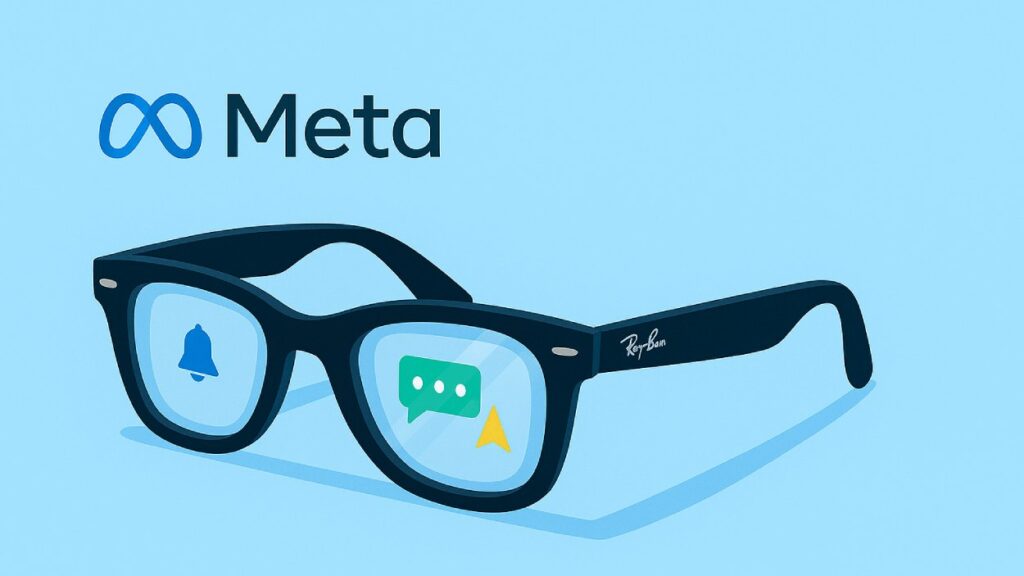Meta’s newest smart glasses blend AI, gesture control, and a built-in display into a stylish pair of Ray-Bans, aiming to shift how we interact with technology.
TLDR:
- Meta introduced the Ray-Ban Display smart glasses with a built-in screen and AI capabilities.
- The glasses work with a wrist-worn Neural Band that uses hand gestures to control functions.
- Priced at $799, the glasses will be available from September 30 in the US.
- New features include real-time translation, video calls, and a bright in-lens display.
What Happened?
At its annual Connect 2025 event, Meta CEO Mark Zuckerberg unveiled the company’s latest push into wearable technology, The Ray-Ban Display smart glasses. Priced at $799, these glasses feature a built-in display inside the right lens and ship with a Neural Band, a wrist-worn controller that lets users interact with the device through hand gestures. The new product will be available in the US starting September 30.
The next evolution of AI glasses is here: meet Meta Ray-Ban Display and Meta Neural Band. Learn more: https://t.co/q0wYlE4hGR
— Meta Newsroom (@MetaNewsroom) September 18, 2025
Meta Wants Smart Glasses to Replace Your Smartphone
Meta is making a serious play to shift user habits from smartphones to wearables. The new Ray-Ban Display glasses are a step forward from previous models, packing more intelligence and interactivity into a sleeker, stylish frame.
- The in-lens display projects notifications, navigation directions, and video calls directly into the user’s field of vision.
- It reaches up to 5,000 nits of brightness, making it easy to use even in direct sunlight.
- The Neural Band uses electromyography (EMG) to pick up signals from your brain when your hand makes a gesture. You can write on a surface or make subtle movements, even with your hand behind your back, and the glasses will respond instantly.
- The band is also waterproof and offers 18 hours of battery life, suitable for workouts and daily use.
Zuckerberg described the glasses as a leap toward “personal superintelligence,” emphasizing that they allow users to stay present in the moment while enjoying AI-powered enhancements like better memory, sharper senses, and easier communication.
Three Models, One Vision
Meta’s latest lineup includes three smart glasses models:
- Ray-Ban Display ($799): The flagship model with a digital display, Neural Band controller, real-time translation, live captioning, and six-hour battery life (plus 30 hours via the case).
- Ray-Ban Meta Gen 2 ($379): A simpler version with 3K video capture, up to eight hours of battery life, enhanced open-ear speakers, and improved clarity in noisy environments.
- Oakley Vanguard ($499): Designed for athletes and outdoor users, featuring larger speakers, a wide-angle camera, water and dust resistance, and integration with platforms like Garmin and Strava.
All three models are being developed in collaboration with EssilorLuxottica, the maker of Ray-Ban frames. According to Meta, sales have tripled in the past year, and production targets are on track to reach 10 million units annually by 2026.
Early Demos Show Promise Despite Glitches
Although the unveiling generated applause, not everything went smoothly. Some of the live demonstrations experienced hiccups, such as a failed video call and a delayed AI recipe test. Still, the overall reception was positive, with many analysts calling it a significant step toward mainstream adoption of smart eyewear.
Zuckerberg even tested the Oakley Vanguard glasses during a surfing session, showcasing their durability and hands-free performance.
Aiming Ahead of the Pack
With rivals like Google, Amazon, Samsung, and Snap also working on AI-powered glasses, Meta is racing to lead this emerging segment. While those companies focus on software ecosystems or AR headsets, Meta is betting big on everyday wearables that combine fashion with functionality.
The Ray-Ban Display glasses undercut competitors like Apple’s $3,000 Vision Pro headset by a wide margin, making Meta’s offering a more affordable and casual entry into the world of AI wearables.
What TechKV Thinks?
I think this is the first time Meta’s vision for everyday AI finally feels practical. These glasses don’t just look good, they actually do useful stuff like showing directions, translating conversations, or answering messages without needing to pull out your phone. The Neural Band is especially exciting. The idea that you can write or gesture discreetly to control your glasses is straight out of science fiction.
While there are still bugs to fix and plenty of skeptics, I’d say Meta has finally nailed the formula for smart glasses that people might actually want to wear. At $799, it’s pricey, but not outrageous for tech that could redefine mobile computing.
